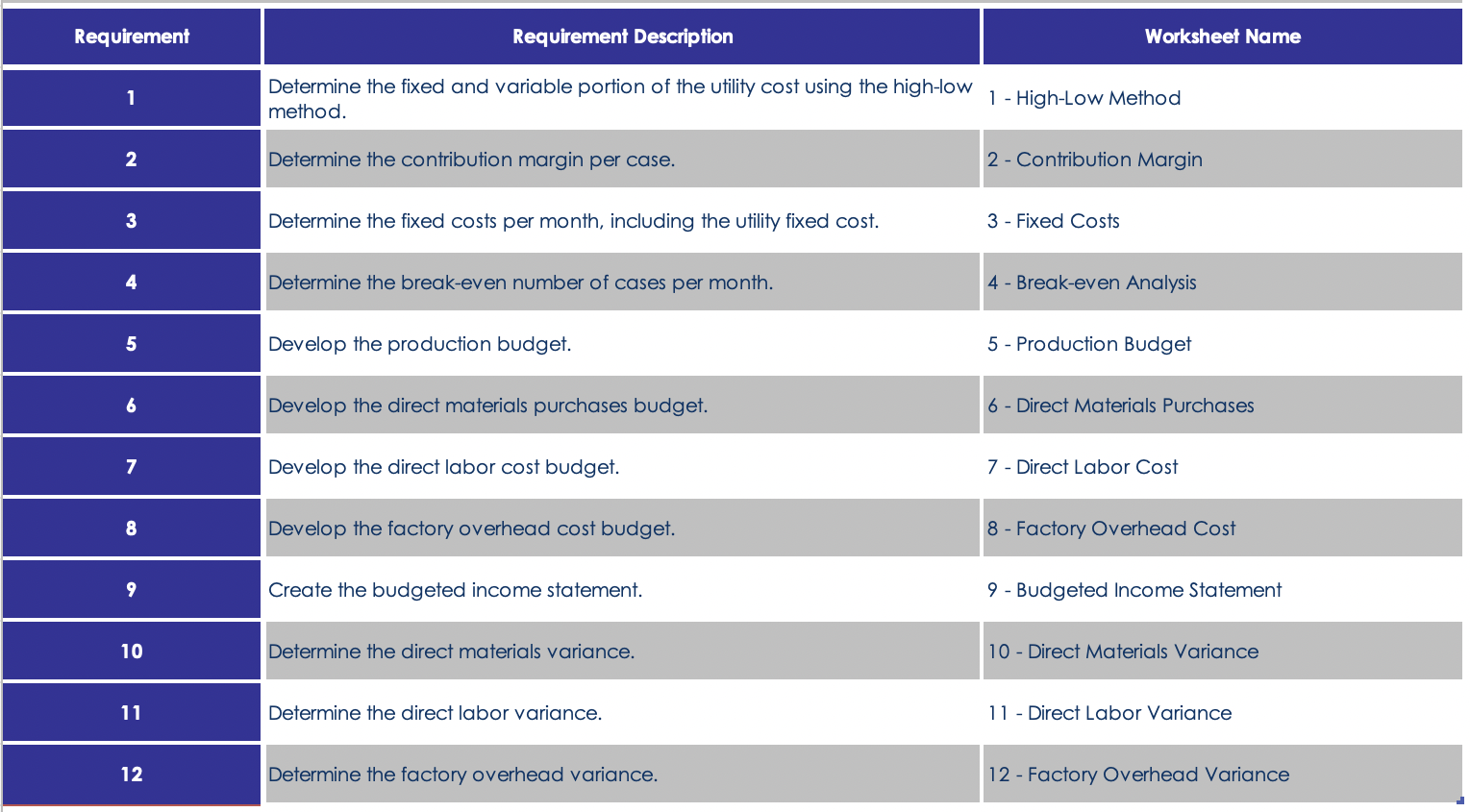
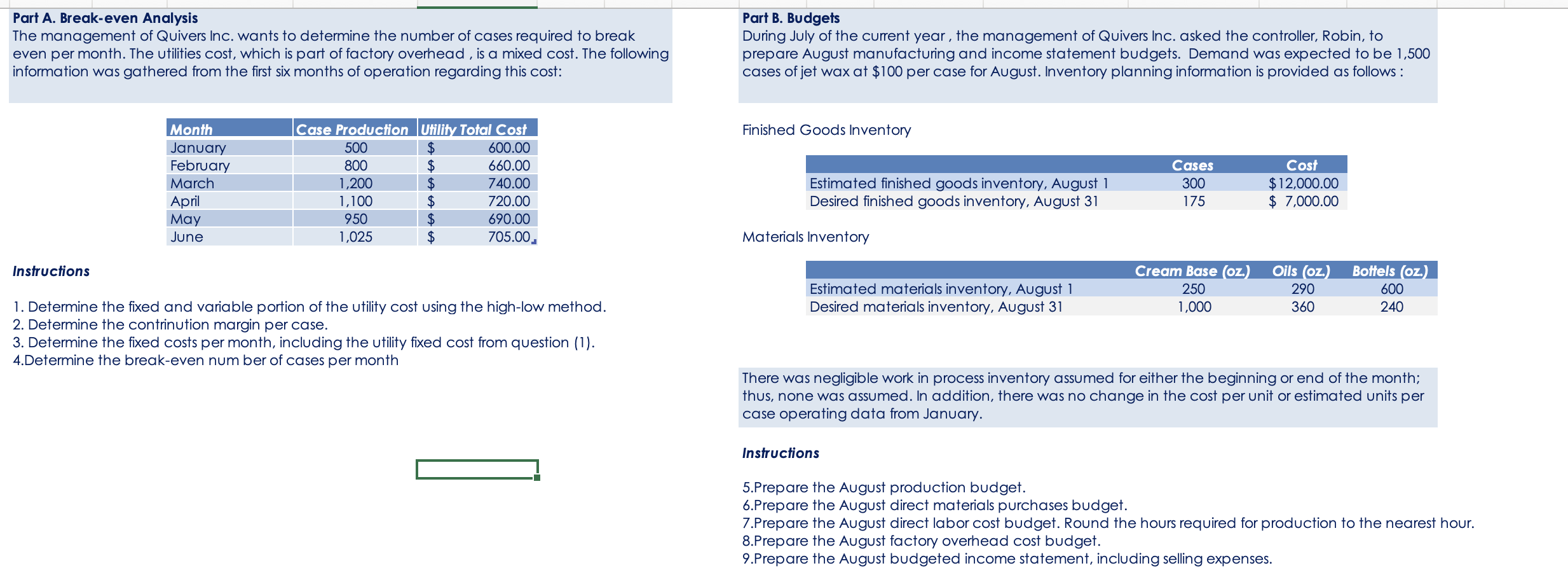
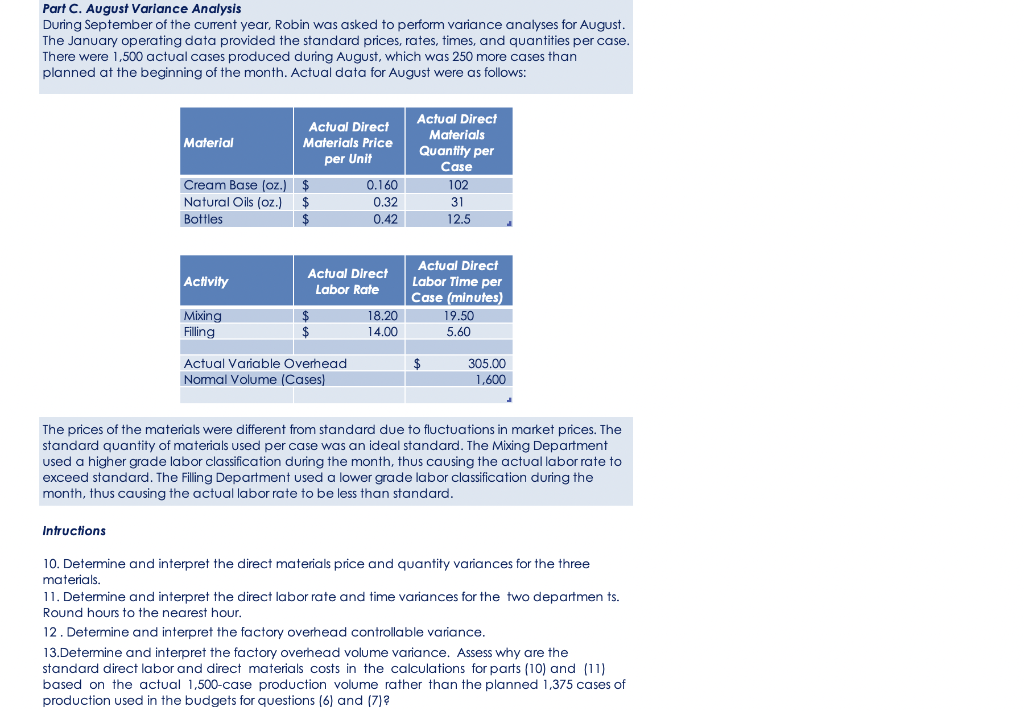
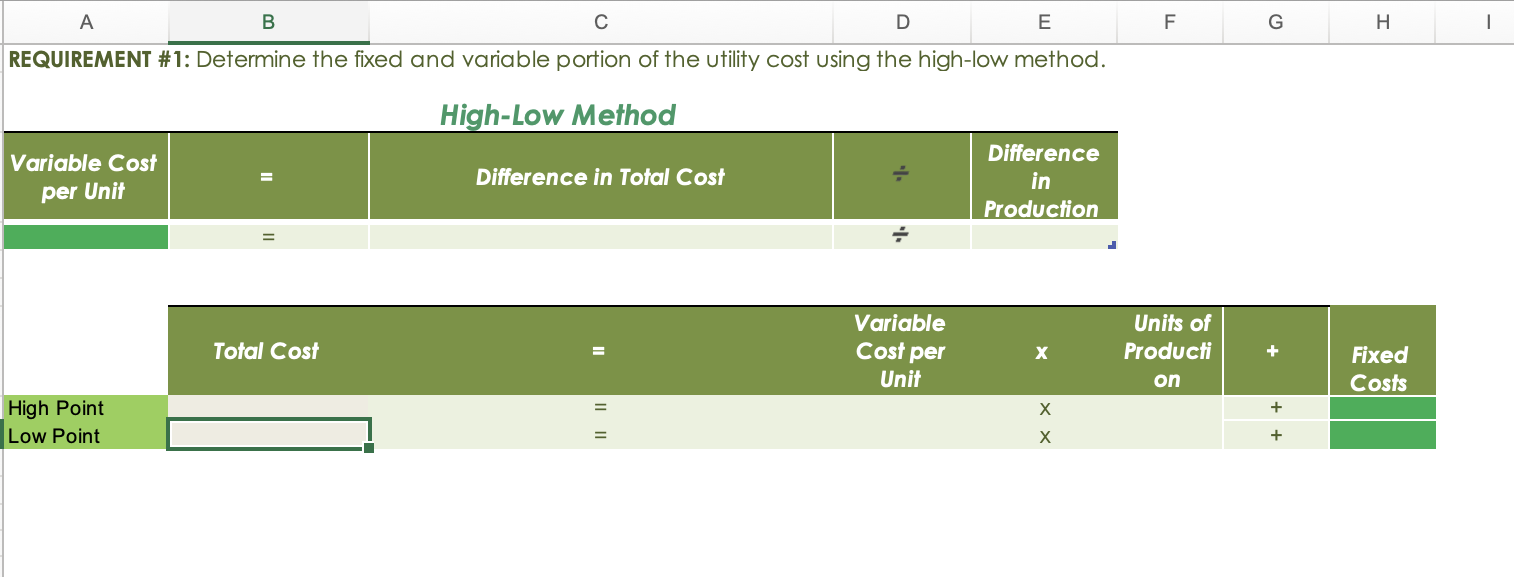
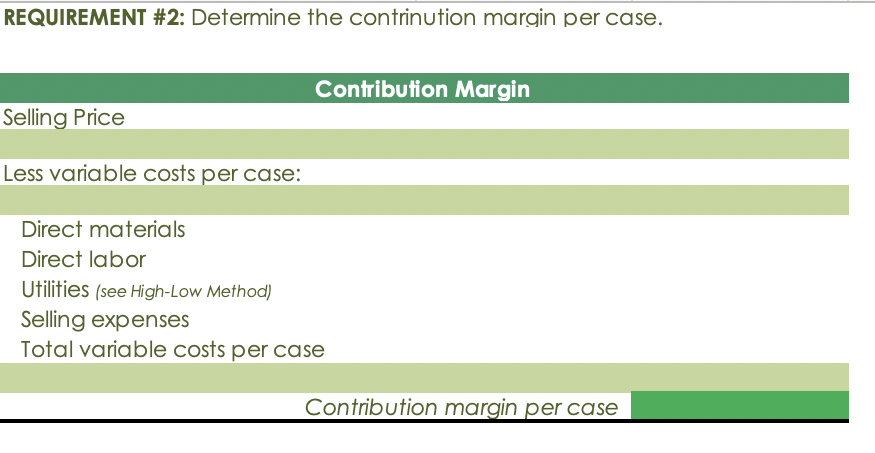


Requirement Requirement Description Worksheet Name 1 Determine the fixed and variable portion of the utility cost using the high-low method. 1 - High-Low Method N Determine the contribution margin per case. 2 - Contribution Margin 3 Determine the fixed costs per month, including the utility fixed cost. 3 - Fixed Costs 4 Determine the break-even number of cases per month. 4 - Break-even Analysis 5 Develop the production budget. 5 - Production Budget 6 Develop the direct materials purchases budget. 6 - Direct Materials Purchases 7 Develop the direct labor cost budget. 7 - Direct Labor Cost 8 Develop the factory overhead cost budget. 8 - Factory Overhead Cost 9 Create the budgeted income statement. 9-Budgeted Income Statement 10 Determine the direct materials variance. 10 - Direct Materials Variance 11 Determine the direct labor variance. 11 - Direct Labor Variance 12 Determine the factory overhead variance. 12 - Factory Overhead Variance Part A. Break-even Analysis The management of Quivers Inc. wants to determine the number of cases required to break even per month. The utilities cost, which is part of factory overhead , is a mixed cost. The following information was gathered from the first six months of operation regarding this cost: Part B. Budgets During July of the current year, the management of Quivers Inc. asked the controller, Robin, to prepare August manufacturing and income statement budgets. Demand was expected to be 1,500 cases of jet wax at $100 per case for August. Inventory planning information is provided as follows : Finished Goods Inventory Month January February March April May June Case Production Utility Total Cost 500 $ 600.00 800 $ 660.00 1,200 $ 740.00 1,100 $ 720.00 950 $ 690.00 1,025 $ 705.00. Estimated finished goods inventory, August 1 Desired finished goods inventory, August 31 Cases 300 175 Cost $12,000.00 $ 7,000.00 Materials Inventory Instructions Estimated materials inventory, August 1 Desired materials inventory, August 31 Cream Base (oz.) 250 1,000 Oils (oz) 290 360 Bottels (oz. 600 240 1. Determine the fixed and variable portion of the utility cost using the high-low method. 2. Determine the contrinution margin per case. 3. Determine the fixed costs per month, including the utility fixed cost from question (1). 4.Determine the break-even num ber of cases per month There was negligible work in process inventory assumed for either the beginning or end of the month; thus, none was assumed. In addition, there was no change in the cost per unit or estimated units per case operating data from January. Instructions 5.Prepare the August production budget. 6.Prepare the August direct materials purchases budget. 7.Prepare the August direct labor cost budget. Round the hours required for production to the nearest hour. 8.Prepare the August factory overhead cost budget. 9.Prepare the August budgeted income statement, including selling expenses. Part C. August Variance Analysis During September of the current year, Robin was asked to perform variance analyses for August. The January operating data provided the standard prices, rates, times, and quantities per case. There were 1,500 actual cases produced during August, which was 250 more cases than planned at the beginning of the month. Actual data for August were as follows: Material Actual Direct Materials Price per Unit Actual Direct Materials Quantity per Case 102 31 12.5 Cream Base (oz.) $ Natural Oils (oz.) $ Bottles 0.160 0.32 0.42 Activity Actual Direct Labor Rate Actual Direct Labor Time per Case (minutes) 19.50 5.60 Mixing Filling 18.20 14.00 $ Actual Variable Overhead Normal Volume (Cases) 305.00 1,600 The prices of the materials were different from standard due to fluctuations in market prices. The standard quantity of materials used per case was an ideal standard. The Mixing Department sed a higher grad labor classification during month, thus causing the actual labor rate to exceed standard. The Filling Department used a lower grade labor classification during the month, thus causing the actual labor rate to be less than standard. Intructions 10. Determine and interpret the direct materials price and quantity variances for the three materials. 11. Determine and interpret the direct labor rate and time variances for the two departments. Round hours to the nearest hour. 12. Determine and interpret the factory overhead controllable variance. 13.Determine and interpret the factory overhead volume variance. Assess why are the standard direct labor and direct materials costs in the calculations for parts (10) and (11) based on the actual 1,500-case production volume rather than the planned 1,375 cases of production used in the budgets rquestions (6) and (7) A B D E F G H 1 REQUIREMENT #1: Determine the fixed and variable portion of the utility cost using the high-low method. High-Low Method Variable Cost Difference in Total Cost Difference in Production per Unit Variable Units of Producti Total Cost = Cost per Unit Fixed Costs on + High Point Low Point + REQUIREMENT #2: Determine the contrinution margin per case. Contribution Margin Selling Price Less variable costs per case: Direct materials Direct labor Utilities (see High-Low Method) Selling expenses Total variable costs per case Contribution margin per case REQUIREMENT #3: Determine the fixed costs per month, including the utility fixed cost from question (1 Total Fixed Costs Utilities (see High-Low Method] Facility lease Equipment depreciation Supplies Requirement #4: Determine the break-even number of cases per month. Break-even Analysis Break-even Sales (units) Fixed Costs Unit Contribution Margin - Requirement Requirement Description Worksheet Name 1 Determine the fixed and variable portion of the utility cost using the high-low method. 1 - High-Low Method N Determine the contribution margin per case. 2 - Contribution Margin 3 Determine the fixed costs per month, including the utility fixed cost. 3 - Fixed Costs 4 Determine the break-even number of cases per month. 4 - Break-even Analysis 5 Develop the production budget. 5 - Production Budget 6 Develop the direct materials purchases budget. 6 - Direct Materials Purchases 7 Develop the direct labor cost budget. 7 - Direct Labor Cost 8 Develop the factory overhead cost budget. 8 - Factory Overhead Cost 9 Create the budgeted income statement. 9-Budgeted Income Statement 10 Determine the direct materials variance. 10 - Direct Materials Variance 11 Determine the direct labor variance. 11 - Direct Labor Variance 12 Determine the factory overhead variance. 12 - Factory Overhead Variance Part A. Break-even Analysis The management of Quivers Inc. wants to determine the number of cases required to break even per month. The utilities cost, which is part of factory overhead , is a mixed cost. The following information was gathered from the first six months of operation regarding this cost: Part B. Budgets During July of the current year, the management of Quivers Inc. asked the controller, Robin, to prepare August manufacturing and income statement budgets. Demand was expected to be 1,500 cases of jet wax at $100 per case for August. Inventory planning information is provided as follows : Finished Goods Inventory Month January February March April May June Case Production Utility Total Cost 500 $ 600.00 800 $ 660.00 1,200 $ 740.00 1,100 $ 720.00 950 $ 690.00 1,025 $ 705.00. Estimated finished goods inventory, August 1 Desired finished goods inventory, August 31 Cases 300 175 Cost $12,000.00 $ 7,000.00 Materials Inventory Instructions Estimated materials inventory, August 1 Desired materials inventory, August 31 Cream Base (oz.) 250 1,000 Oils (oz) 290 360 Bottels (oz. 600 240 1. Determine the fixed and variable portion of the utility cost using the high-low method. 2. Determine the contrinution margin per case. 3. Determine the fixed costs per month, including the utility fixed cost from question (1). 4.Determine the break-even num ber of cases per month There was negligible work in process inventory assumed for either the beginning or end of the month; thus, none was assumed. In addition, there was no change in the cost per unit or estimated units per case operating data from January. Instructions 5.Prepare the August production budget. 6.Prepare the August direct materials purchases budget. 7.Prepare the August direct labor cost budget. Round the hours required for production to the nearest hour. 8.Prepare the August factory overhead cost budget. 9.Prepare the August budgeted income statement, including selling expenses. Part C. August Variance Analysis During September of the current year, Robin was asked to perform variance analyses for August. The January operating data provided the standard prices, rates, times, and quantities per case. There were 1,500 actual cases produced during August, which was 250 more cases than planned at the beginning of the month. Actual data for August were as follows: Material Actual Direct Materials Price per Unit Actual Direct Materials Quantity per Case 102 31 12.5 Cream Base (oz.) $ Natural Oils (oz.) $ Bottles 0.160 0.32 0.42 Activity Actual Direct Labor Rate Actual Direct Labor Time per Case (minutes) 19.50 5.60 Mixing Filling 18.20 14.00 $ Actual Variable Overhead Normal Volume (Cases) 305.00 1,600 The prices of the materials were different from standard due to fluctuations in market prices. The standard quantity of materials used per case was an ideal standard. The Mixing Department sed a higher grad labor classification during month, thus causing the actual labor rate to exceed standard. The Filling Department used a lower grade labor classification during the month, thus causing the actual labor rate to be less than standard. Intructions 10. Determine and interpret the direct materials price and quantity variances for the three materials. 11. Determine and interpret the direct labor rate and time variances for the two departments. Round hours to the nearest hour. 12. Determine and interpret the factory overhead controllable variance. 13.Determine and interpret the factory overhead volume variance. Assess why are the standard direct labor and direct materials costs in the calculations for parts (10) and (11) based on the actual 1,500-case production volume rather than the planned 1,375 cases of production used in the budgets rquestions (6) and (7) A B D E F G H 1 REQUIREMENT #1: Determine the fixed and variable portion of the utility cost using the high-low method. High-Low Method Variable Cost Difference in Total Cost Difference in Production per Unit Variable Units of Producti Total Cost = Cost per Unit Fixed Costs on + High Point Low Point + REQUIREMENT #2: Determine the contrinution margin per case. Contribution Margin Selling Price Less variable costs per case: Direct materials Direct labor Utilities (see High-Low Method) Selling expenses Total variable costs per case Contribution margin per case REQUIREMENT #3: Determine the fixed costs per month, including the utility fixed cost from question (1 Total Fixed Costs Utilities (see High-Low Method] Facility lease Equipment depreciation Supplies Requirement #4: Determine the break-even number of cases per month. Break-even Analysis Break-even Sales (units) Fixed Costs Unit Contribution Margin













